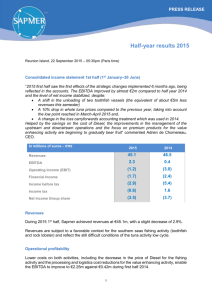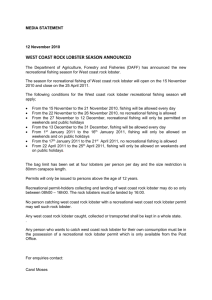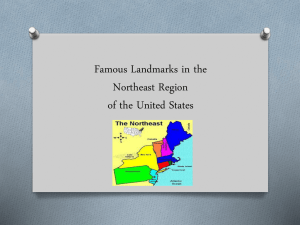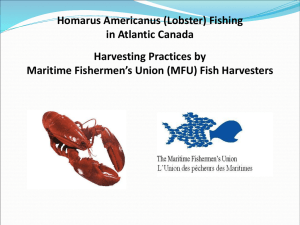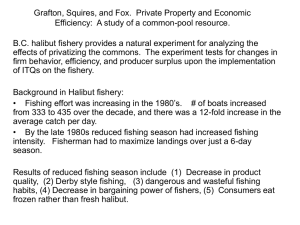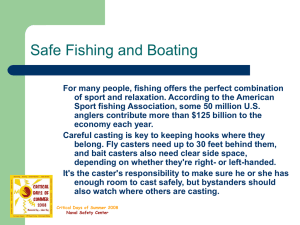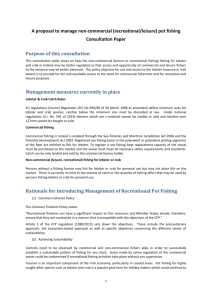James Acheson, The Lobster Fiefs: Economic and Ecological Effects
advertisement
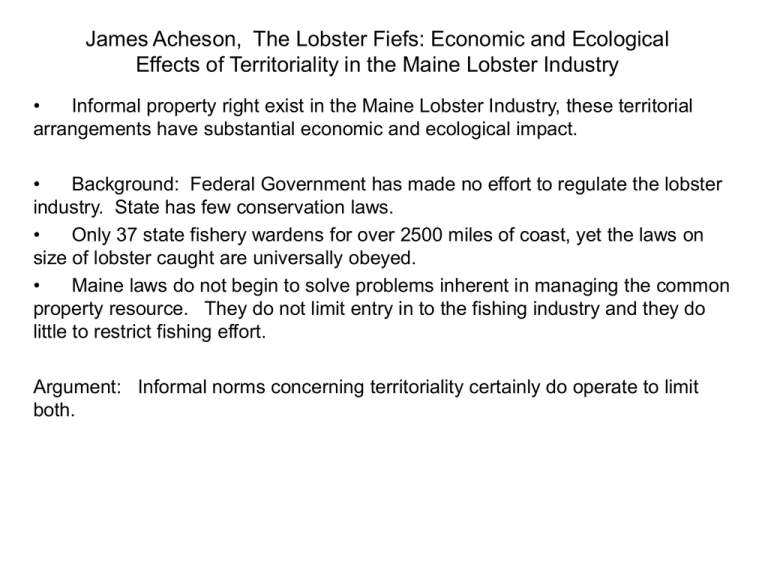
James Acheson, The Lobster Fiefs: Economic and Ecological Effects of Territoriality in the Maine Lobster Industry • Informal property right exist in the Maine Lobster Industry, these territorial arrangements have substantial economic and ecological impact. • Background: Federal Government has made no effort to regulate the lobster industry. State has few conservation laws. • Only 37 state fishery wardens for over 2500 miles of coast, yet the laws on size of lobster caught are universally obeyed. • Maine laws do not begin to solve problems inherent in managing the common property resource. They do not limit entry in to the fishing industry and they do little to restrict fishing effort. Argument: Informal norms concerning territoriality certainly do operate to limit both. • From a legal standpoint, anyone with a license can go fishing anywhere, in reality, far more is required (acceptance into a harbor gang). • Delineation of boundaries varies with distance from shore. Close to shore, boundaries are often known to the yard, offshore they are less definite. • Failure to obey the informal property rights often ends up in threats of violence, cutting traps, even full blown lobster wars. • Two types of lobster fishing areas (1) Nucleated and (2) Perimeter Defended. Shifting from (2) to (1) explains some of the overexploitation of lobster in Maine. (1) Nucleated fishing areas • Ownership of fishing rights is strong close to shore or harbor, but grows weaker the farther from harbor one goes. A good deal of mixed fishing takes place (multiple gangs fishing) on periphery. A stranger fishing close to harbor would certainly be met with violent opposition. The reaction would be much less violent if he were to invade a mixed area where sense of ownership is much weaker. Relatively easy to gain acceptance into harbor gangs (live in area, live by the local social norms) • • (2) Perimeter Defended fishing areas • Boundaries are sharply drawn and defended to a yard. Sense of ownership does not decline with distance from where the owners anchor their boats. Very little mixed fishing. Claims on ocean areas are tied up with formal ownership of land. (e.g. Island ownership includes right to exclusively fish nearby waters) Even if owner is not using his territory, his fishing rights remain, and can even be rented out. Entry to harbor gangs is essential limited to men who belong to families owning land and adjacent water areas. Prior to 1920, all lobster areas were type (2), most today are type (1). • • • • • • Conservation efforts are practiced in type (2). e.g. Voluntarily agreed to limit the number of traps they fish. Ecological and economic implications include a) Decreased production cost. b) Lower lobster mortality rates c) Trap limits do NOT cut down total catch. When trap limits are imposed, men dispense with the marginal traps and put remainder to better use. Yield per trap increases. d) Men in type (2) have substantially larger incomes, catching more and bigger lobsters. e) This occurs at a reduced fishing effort. Management Implications • State of Maine does not take advantage of the principle of having more well defined property rights. • State has not instituted any of the conservation measures men in (2) have instituted for themselves. • Administrative cost with establishing and maintaining small exclusive fishing areas would be prohibitive. At national / regional levels attempts to regulate fisheries by manipulating fishing season, type of fishing gear. Argument: quotas and seasons are ineffective in preventing the tragedy of the commons. The only effect is to make fishing more inefficient (e.g expensive boats tied up to the dock, skillful fisherman in welfare lines half of the year.) A much better management system would be limiting entry, as is the case in perimeter defended areas of Maine. Lesson: More stringently defined/enforce property rights produces effective solution to the commons problem



